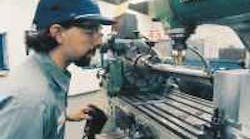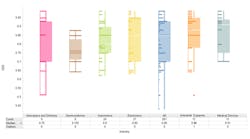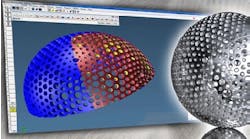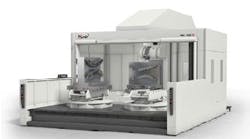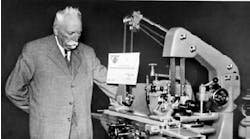Two training programs, one an apprenticeship, the other an established educational institute, give students the skills they need to be top-notch employees.
Hydromat Apprentice Brad Burmaster carefully checks a milling operation.
Specialized skill training at Hobart Institute of Welding is offered both at the center and at a customer's facility.
A group of apprentices at Hydromat discuss tooling prints in the toolroom.
In the Hydromat program, journeyman Guido Girardi and apprentice Jerry Neuhaus together go through setup steps on a Charmilles EDM.
Whether its welding or machining, companies are getting involved in the fight to put skilled workers into the workforce. Two industry leaders are dealing with this common problem differently, but both effectively. Hobart Brothers of Troy, Ohio, has its Hobart Institute of Welding Technology— an established, revenue-generating institute that has been working to help students become skilled employees for 68 years. The other company, Hydromat/Turmatic Systems, St. Louis, is getting potential employees up to par by offering an intense, four-year apprenticeship program to students who can then go on to work at the company. Both programs have met their goals: to make better workers, and in turn, a better industry.
The Hobart Institute of Welding
The institute serves many purposes, as a college for full-time welding students and an application and training center for customers of Hobart. Skill training classes can range from 2 to 6 weeks for customers, but full-time student programs run 5 or 9 months. As President David F. Manning explains, "There are 2 parts to the college. One part is focused on students, and the other part is focused on industry needs."
By industry needs, Manning is referring to Hobart customers and customer employees who have application problems, want to improve general skills, or want specific skill training. Specialized skill training is available in week blocks.
Customers don't have to come in-house for the training either. There are 12 instructors at HIWT that do nothing but go out on the road. Most traveling instructors are in demand for their skills in welding-product maintenance. But the instructors also deal with helping clients use equipment in a more efficient manner.
Manning stresses, however, that the institute is not just a service center used for introducing Hobart products to customers. "Our training is focused on the process and not product training, and we charge for it. We try to emphasize what the customer gains through training," says Manning.
Because the programs are offered at a cost, customer training sessions are always tailored around the customer's specific needs. "If a customer only wants to know one thing, we focus on that in training," says Manning. The institute will deal with any special training and application issues, but there is also a set program in place. The program is designed to be modular, so if a company is only interested in learning certain aspects of welding, Hobart can just use modules that meet the customers' needs.
Training is not limited to customer employees who are on the shop floor. There are also courses for supervisors, engineers, and inspectors who need to know more about welding. In these general skill classes, the main focus tends to be on classroom work.
But the reverse is true in the 5 to 9-month skill courses for full-time students where 85-90% of work is done in the welding stations.
As Manning says, "We feel that is where we can really instruct how to do good welding. You can't get that skill in the classroom. We dedicate one person to one station, and all the equipment is there for each student to work alone and have everything he needs."
There are 144 stations for these full-time students. Students in the 5 to 9-month programs come to the school daily to pursue welding as a career, and like any college, financial aid, scholarships, and housing are available. The 50,000 ft 2 facility also has four labs and 13 classrooms. The instructor ratio is 12:1, and the institute has a full time person in the certification lab.
At the end of the 5 or 9-month course, students receive grades based on their physical skills, knowledge, and attitude. The school also offers certification for students, and institute standards are based on the American Welding Society (AWS) and the American Society of Mechanical Engineers.
Giving the students the experience they will need in the real world is important to Manning and his staff. " They weld thick to thin materials, plate, pipes-you name it. We have instructors from industry. And even though all our machines are new, we have very basic to leading-edge technology. Our job is to prepare students for the workforce. They will encounter a wide variety of situations, and we try to promote flexibility because the workforce of tomorrow has to be flexible."
The technology at the facility was updated when all equipment was replaced last year with newer machines. "We are making major investments to stay in the fore-front of technology. In addition to the new equipment, we have live demo capability in classes now, and we just redid the ventilation system. The next project update will be the classrooms."
Placement is not a problem for graduates. A month before they are ready to graduate, they contact the counselor to talk about the market, area, and industry where they have interests. The school keeps a listing of jobs needed throughout the country from Hobart's customers. Right now with the demand, HIWT places almost all their students.
Manning is excited about the future of training and the potential his students have for great careers in welding. "It is rewarding to see our students come through here and succeed. People have gone on to own their own business or be executives in corporations. Or they continue on with the college track. It is a good career. Where else can you get such a return on your investment, and come out with such potential?"
The institute is on the internet at www.welding.org where it will soon sell its training materials, offer registration, and currently keeps certification records.
Apprenticeship program to be admired
Students in machining often have a tough time finding thorough, certified training that guarantees learning industry skills and landing a good job. Precision transfer machine maker Hydro-mat/Turmatic Systems, however, offers just that sort of program. Ruedi Abderhalden, machine shop and apprentice manager, says that the intensive apprenticeship program currently has 14 apprentices—seven in the last year of the four-year program, three in the third year, one in the second, and three in the first.
The program has graduated more than 40 apprentices in machining and was created in 1983 by current President and CEO Bruno Schmitter.
"Our program," Abderhalden says, "is very serious and structured. We do not just put a man on a lathe for certain number of years and then call him a journeyman. We're certified by the National Tooling and Machining Association (NTMA) and recently by the Deptartment of Labor."
In order to get certified by these institutions, a program must meet the requirements set forth in regulation 29CFR29. The 22 criteria include specifications such as 8,000 hours of hands-on training and 576 hours in the classroom.
Harold Behlke, who graduated from the Hydromat program a year ago, says, "The Hydromat approach teaches you all the aspects of the trade, including discipline. You see how your trade fits in with the rest of the company— sales, quality assurance, engineering, manufacturing, assembly, toolmaking, and customer service. We serve time in every department."
According to Behlke, this was the only structured program he could find. He spoke with several other prospective employers who said, "Sure, we'll give you an apprenticeship." But what that meant, Behlke says, is that they would guarantee him low wages for the first four years while he ran their drill press, and at the end they would give him a journeyman card certified by their company. "I wanted more, " he says. "That's how I ended up at Hydromat. I learned up front what it offered— every detail about the structure of the program. Hydromat told me who stood behind its program. My journeyman's papers are certified by the Department of Labor, NTMA, and Hydromat."
The apprentices have weekly classroom studies and tests, and every six months there is a practical and theoretical final. Apprentices are also assigned a project based on engineering drawings. The project is evaluated by Abderhalden and another journeyman from the shop who has expertise in the project area. All apprentices are evaluated in ongoing fashion as well, with respect to their day-to-day assignments in the shop.
"It is a strictly structured program," Abderhalden says, "but, so too is real-life work. We strive to stagger the program. The exams and projects get increasingly more difficult as the apprentice moves forward, up to the last year where there is CNC milling, turning, EDM, and tool and cutter grinding."
At the end of the year, the apprentice is ready to master just about every task, according to Abderhalden. "As he approaches his final year, he is almost entirely integrated here. He works with customers, does machine run-offs, is out in the field installing machines. Gradually, during the four years, the apprentice has blended in so well that there really is no significant transition from the program to journeyman employee."
In the fourth year, the apprentice and the company consider where the apprentice will fit best upon the completion of the program. Abderhalden says that, in most cases, a graduate usually ends up where he wants. If there isn't an immediate opening, his experience lets him work in another department until something opens up.
Abderhalden estimates that it costs the company between $18,000 and $21,000 per apprentice— exclusive of salary— for the four year program. A fourth year apprentice earns roughly 25% to 30% less than a full-fledged journeyman.
"An investment of $18,000 to $21,000 might seem like a lot," Abderhalden says. "But it's management's position that this is an investment in our future. We have to invest in people just like we'd invest in technology. Many companies would view this as overhead. But we see it as preparing a talented, literate, trained future workforce, one that we'll want to keep and one that will want to stay with us."
The numbers seem to bear this out. Of the employees who have graduated in the last 10 years, less than 2% have left Hydromat.
"We take a long-range view," Abdehalden adds. "Training isn't expendable, any more than machinery or customers. Training goes on far beyond the apprentice-ship program too. It's an ongoing company-wide commitment. We make long-term commitments to our customers. Likewise, we make long-term commitments to the training and advancement of our employees."
